Definition, Formula, Conditions, Characteristics, Solved Example Problems - Binomial Distribution | 11th Statistics : Chapter 10 : Probability Distributions
Chapter: 11th Statistics : Chapter 10 : Probability Distributions
Binomial Distribution
BINOMIAL DISTRIBUTION
Introduction
Binomial distribution was discovered by James Bernoulli (1654 ŌĆō
1705) in the year 1700 and was first published in 1713 eight years after his
death. The distribution of the Sum of n independent Bernoulli variables is
known as a Binomial distribution.
That is the sum of outcome of n independent experiments of
Bernoulli trials, in each of which the probability of success is constant p and
the probability of failure is q=1ŌĆō p is called Binomial experiment.

Conditions for Binomial Distribution
We get the Binomial Distribution under the following
experimental conditions:
i.
The number of trials `nŌĆÖ
is finite
ii.
The trials are independent of each other
iii.
The probability of success `pŌĆÖ
is same for each trial
iv.
Each trial must result in a success or a failure.
Characteristics of Binomial Distribution
i. Binomial distribution is a discrete distribution i.e., X can take values 0, 1, 2, ... n where `nŌĆÖ is finite .
ii.
Constants of the distributions are:
Mean
= np; Variance = npq; Standard deviation = ŌłÜnpq

iii.
It may have one or two modes.
iv.
If X~B( n1,p) and Y~B(n2,p) and that X and Y are
independent then X+Y~B(n1+n2,p)
v.
If `nŌĆÖ independent trials are repeated N
times the expected frequency of `xŌĆÖ successes is N├Ś
nCx px qnŌĆōx
vi.
If p = 0.5, the distribution is symmetric.
Example 10.1
Comment
on the following 'The mean of binomial distribution is 5 and its variance is
9'.
Solution:
Given
mean np = 5 and variance npq = 9

as
0 < q < 1 and hence the given
statement is wrong.
Example 10.2
Eight
coins are tossed simultaneously. Find the probability of getting atleast six
heads.
Solution:
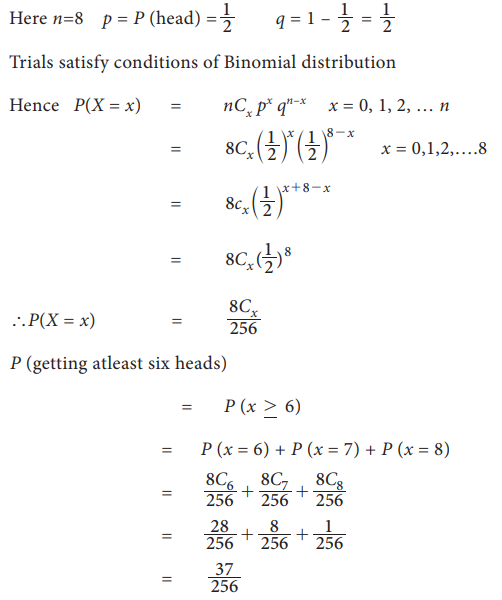
Example 10.3
Ten
coins are tossed simultaneously. Find the probability of getting (i) atleast
seven heads (ii) exactly seven heads (iii) atmost seven heads.
Solution:
X denote the number of heads appear
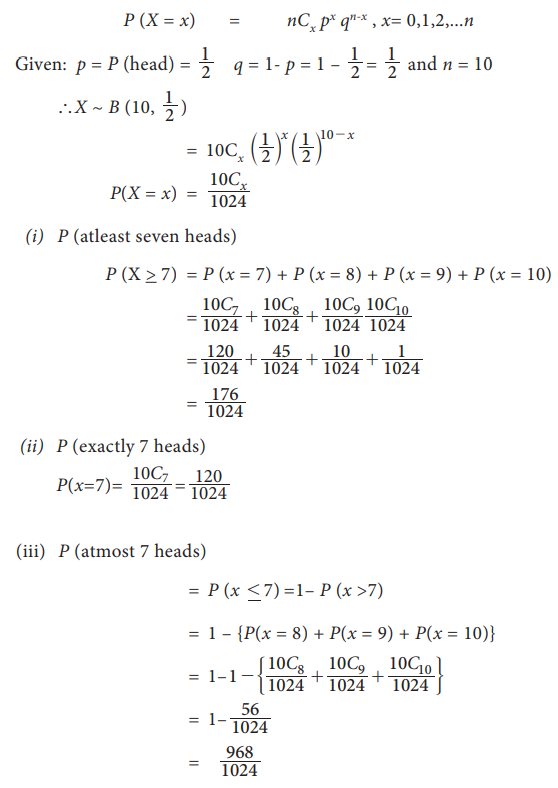
Example 10.4
With
usual notation find p for Binomial random variable X if n = 6 and 9 P(x
= 4) = P (x = 2)
Solution:
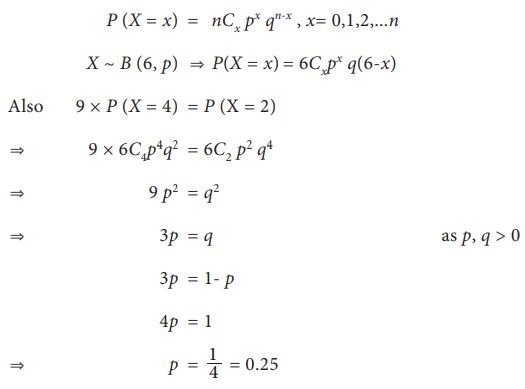
Example 10.5
A
Binomial distribution has parameters n=5 and p=1/4. Find the Skewness and
Kurtosis.
Solution:

Finding: The distribution is positively
skewed.
Kurtosis
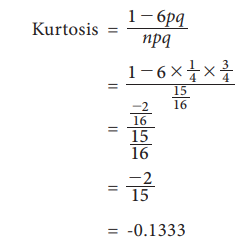
Finding: The distribution is Platykurtic.
Example 10.6
In
a Binomial distribution with 7 trials, P(X=3)=P(X=4) Check whether it is a
symmetrical distribution?
Solution:
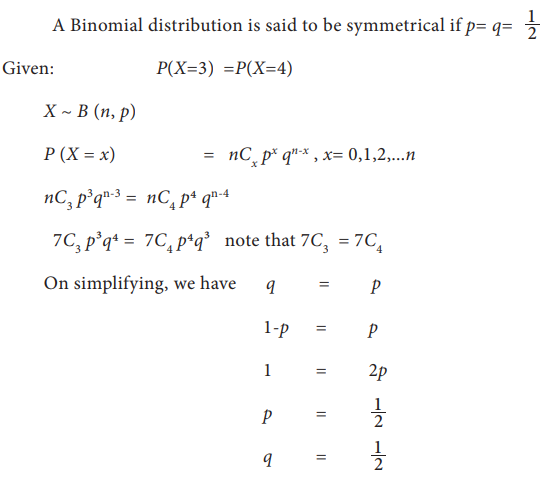
Hence
the given Binomial distribution is symmetrical.
Example 10.7
From
a pack of 52 cards 4 cards are drawn one after another with replacement. Find
the mean and variance of the distribution of the number of kings.
Solution:
Success
X=event of getting king in a draw
p=probability of getting king in a
single trial

Example 10.8
In
a street of 200 families, 40 families purchase the Hindu newspaper. Among the
families a sample of 10 families is selected, find the probability that
i.
Only one family purchase the news paper
ii.
No family purchasing
iii.
Not more than one family purchase it
Solution:
X
~ B (n, p)
P (X = x) = nCxpx qn-x
, x= 0,1,2,...n
Let X denote the
number of families purchasing Hindu Paper
p = Probability of their
family purchasing the Hindu
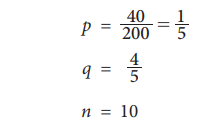
(i) Only one family purchase the Hindu
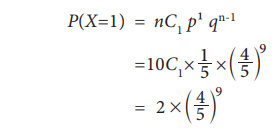
(ii) No family purchasing the Hindu

(iii) Not more than one family purchasing The Hindu means that XŌēż1
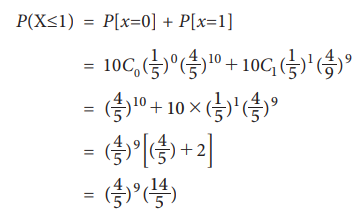
Example 10.9
In a tourist spot, 80% of tourists are repeated visitors. Find
the distribution of the numbers of repeated visitors among 4 selected peoples
visiting the place. Also find its mode or the maximum visits by a visitor.
Solution:
Let the random variable X
denote the number of repeated visitors.
X ~ B (n, p)
P (X = x) = nCxpxqn-x
, x= 0,1,2,...n
It is a Binomial
Distribution with n=4
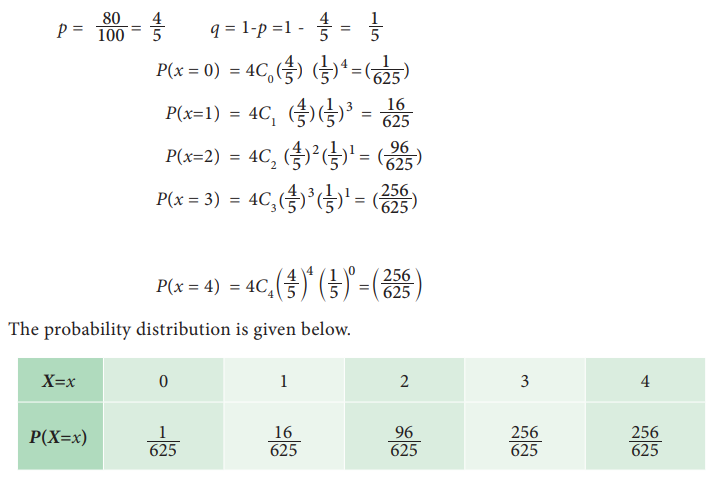
Example 10.10
In a college, 60% of the students are boys. A sample of 4
students of the college, is taken, find the minimum number of boys should it have so that probability up
to that number is Ōēź 1/2.
Solution:
It is given that 60% of the students of the college are boys and
the selection probability for a boy is 60% or 0.6 As we are taking four
samples, the number of trials n = 4.
The selection process is independent.
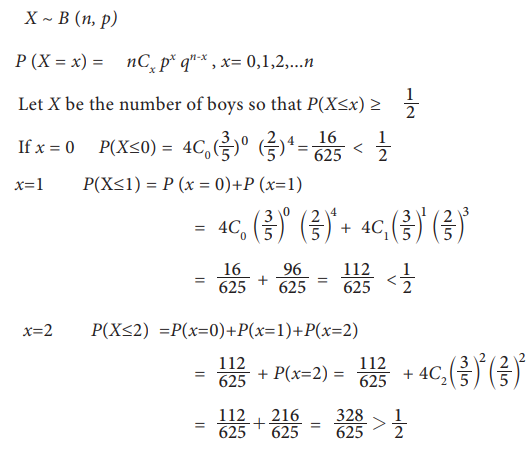
Therefore
the sample should contain a minimum of 2 boys.
Related Topics